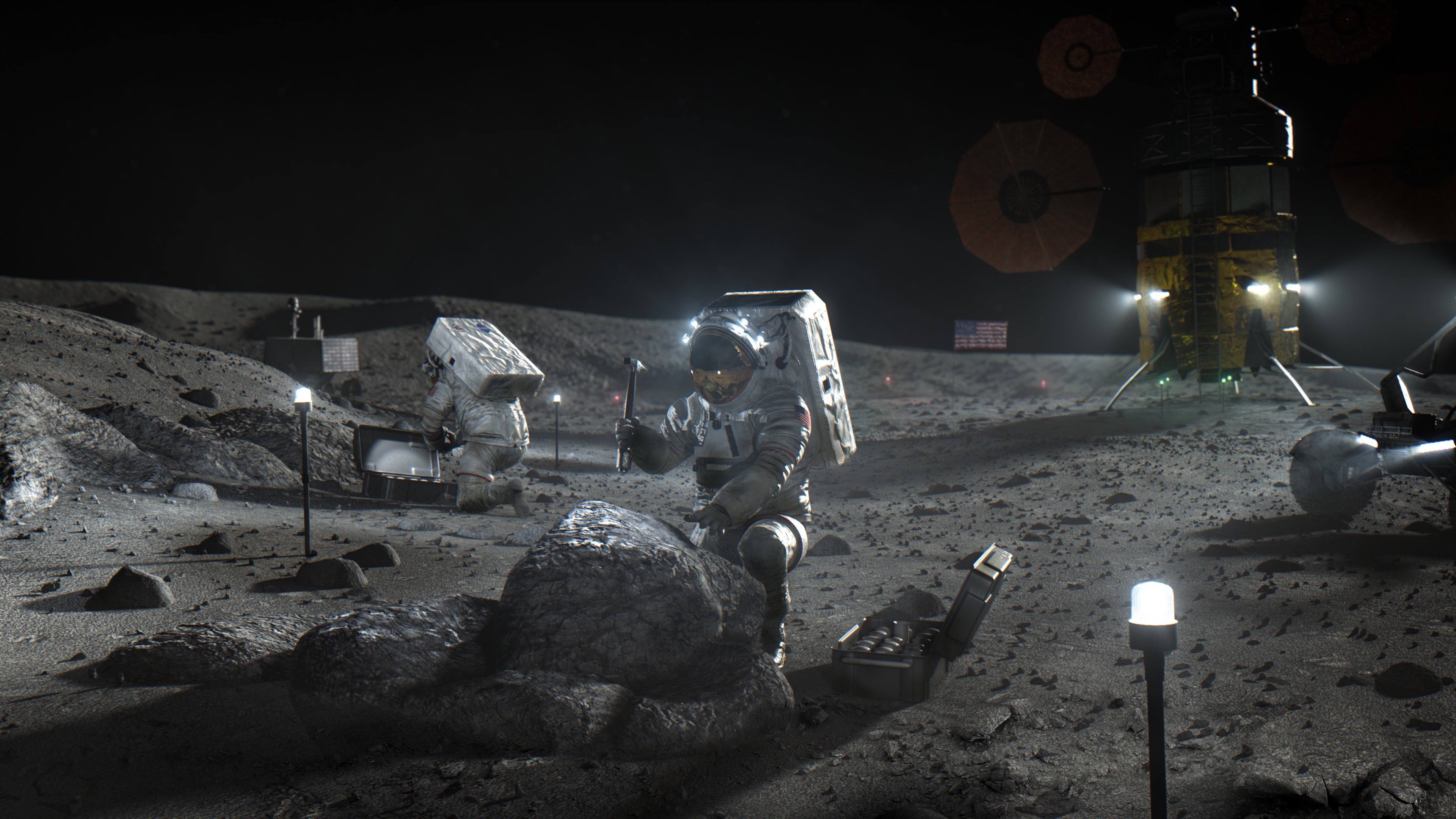NASA’s Artemis program has been called ambitious for its goal of returning humans to Earth’s moon as early as 2024. But its most audacious aspiration is something else entirely: a plan to usher in an era of sustainable lunar operations by mining the moon’s reserves of water ice. Once tapped, this extraterrestrial reservoir could become the elixir of life to support human outposts, supplying not only drinking water but also oxygen and even rocket fuel.
Although water ice has been detected in the shadowy depths of craters at the natural satellite’s poles, there remains a paucity of in-depth scientific data to truly tag it as water-rich. Creating a sustainable human presence on the moon requires addressing two major, fundamental unknowns: Just how much ice is available to use there? And just how hard would it be to extract?
Over the next few years, NASA will dispatch an array of spacecraft to quench its thirst for more water-ice data—and to sustain its quest for an Artemis Base Camp to support wide-ranging human lunar exploration.
Lunar Hitchhikers
Several low-cost miniaturized spacecraft dubbed CubeSats will soon be dispatched to the moon as secondary payloads onboard the Artemis I rocket—the maiden flight of NASA’s powerful Space Launch System. The rocket is now targeted for a 2021 takeoff.
It will include Lunar Flashlight, a Jet Propulsion Laboratory–led CubeSat mission designed to illuminate and study ice on the moon’s surface. The spacecraft will use near-infrared lasers to shine light into its dark polar regions while an onboard reflectometer will measure surface texture and composition.
Also onboard Artemis I will be Lunar IceCube, a spacecraft designed and built by a team at Morehead State University that will look for water ice and other resources on the moon. It will also judge the distribution of water and additional volatiles as a function of time of day, latitude, and the lunar surface’s age and composition. Unlike Lunar Flashlight, Lunar IceCube’s studies are not chiefly confined to the moon’s shadowed areas.
Then there is the Lunar Polar Hydrogen Mapper, or LunaH-Map. The size of a shoebox, LunaH-Map is an Arizona State University-–led effort to map hydrogen-rich regions (which typically correspond to ice deposits) within permanently shadowed areas of the lunar south pole.
For good measure, there is also Lunar Trailblazer—a California Institute of Technology–led mission to quantify and study water on the moon that will launch separately from the trio of spacecraft onboard Artemis I. Using advanced infrared sensors, it will produce a high-resolution map to chart the form, abundance, and distribution of water and further clarify the environmental conditions in which lunar water exists. Too large to be classified as a CubeSat, this spacecraft can discern which permanently shadowed craters have large water ice deposits at the surface and which are “empty” or possess less easily extractable hydrated minerals. Lunar Trailblazer could be ready to launch by the end of 2022. But it may not lift off until 2024, when it is slated to get a ride on NASA’s Interstellar Mapping and Acceleration Probe (IMAP) mission.
On a Roll
In some ways, NASA is already on a roll when it comes to prowling the moon in search of water ice. On June 11 the agency announced that it awarded a contract valued at $199.5 million to the Pittsburgh-based aerospace company Astrobotic Technology for the deployment of the yet another mission: the Volatiles Investigating Polar Exploration Rover (VIPER)—using the company’s Griffin lander.
The deal is part of the space agency’s Commercial Lunar Payload Services program, in which NASA contracts with private companies to plop gear onto the lunar landscape. The agency provides only the payloads and cash for services rendered.
The plan calls for the golf-cart-sized VIPER to roll off of Astrobotic’s lander at a still-undetermined locale in the vicinity of the moon’s south pole in 2023. During its 100-Earth-day mission, the rover will traverse several kilometers and use science instruments to examine various lunar environments in search of water ice. The rover will also have a drill to poke as far as a meter down into the moon’s surface.
The exact price tag of VIPER itself remains to be determined, according to Lori Glaze, director of NASA’s planetary science division. But the mission is moving forward. As for the water-ice quest, “we have a lot of big questions —not knowing what it is, where it is, what else is there with it,” she said in a recent media briefing.
Proving the Reserves
Although their overlapping objectives may seem to make some of these missions redundant, in truth, there is so much work to be done preparing for a lunar water-ice gold rush that even more spacecraft could be required.
So far all the signals and measurements gathered from remote-sensing probes constitute only a preliminary indication of the existence of water on the moon, says Angel Abbud-Madrid, director of the Center for Space Resources at the Colorado School of Mines. “Borrowing terminology from the mining industry, we only know the water on the moon as an ‘inferred resource’ and not as a ‘proven reserve,’” he says. The latter “is required to establish an economically attractive extraction operation for commercial purposes or to assure space agencies that crews can depend on this water for their survival.”
Reaching that vaunted level, Abbud-Madrid foresees, will require a far more comprehensive and orchestrated lunar-prospecting campaign: a fleet of spacecraft that would include a multitude of low-cost impactors and drilling and trenching samplers, as well as swarms of robotic rovers. Without that sort of robust effort, the data on lunar water ice deposits will remain “much too sparse, coarse and uncertain to do more than broad-brush planning,” says Leslie Gertsch, a geologist at Missouri University of Science and Technology.
The VIPER mission, in particular, she says, could be the first part of a multistage effort to pinpoint and characterize water-ice deposits in detail on the ground, as well as from orbit. From there, subsequent investigations could gather more and finer information about the physical form and purity of the actual ice deposits, which will likely be intermixed with some amount of lunar soil. Eventually, all that hard-won knowledge could allow more sophisticated and lucrative activities—from planning excavations to setting up processing plants and scheduling production runs.
Without such a vast data set, meaningful progress on crafting possible approaches to mining and processing deposits may prove elusive. “Innovative methods being devised now could turn out to be either misguided dead ends or brilliant leaps forward,” Gertsch says. “Histories of mining districts on Earth are filled with examples of both. We can learn from the past.”
One of the lessons that should be learned, according to Kevin Cannon, a postdoctoral researcher at the University of Central Florida, is not to make every mission strictly about science. Many of the unknowns most relevant for developing lunar ice as a resource, such as which deposits would be most accessible and economical to mine, are of minimal scientific interest.
“My view is that these new orbiters, like LunaH-Map and Lunar Trailblazer, are going to mostly provide incremental improvements in what we already know,” Cannon says. To answer the most important questions about the amount and quality of ice, he adds, on-the-spot sleuthing by robotic probes—and eventually humans—will likely be necessary.
“I think the VIPER rover is a great start, although it’s geared toward science,” Cannon says. “We’ll need dedicated, resource-focused missions to really get a sense of the economic potential.”

A New Lunar Pact
What seems certain is that as the world gains a better understanding of the moon’s potential economic value, new regulations dictating activities there will likely become necessary. Consequently, in May NASA unveiled a summary of what the space agency calls the Artemis Accords. “We needed something new. A new legal framework to support Artemis activities,” says Mike Gold, NASA’s acting associate administrator for international and interagency relations and a key leader in shaping the accords.
One of their key principles is tied to future use of resources on the moon. Specifically, the accords’ summary document states, “The ability to extract and utilize resources on the Moon, Mars, and asteroids will be critical to support safe and sustainable space exploration and development.”
But that declaration depends on what the moon truly has to offer. “We don’t even know what the unknown unknowns are, relative to the moon,” Gold says. “We have really just begun to scratch the surface of our knowledge of what the physics, what the geology and what the opportunities of the moon will be.”
That uncertainty is why the principles in the Artemis Accords need to be relatively general, Gold says. “For now, we need to proceed cautiously in a generic fashion. We’re going to learn things, and I expect surprises,” he adds. “I’m sure there will be an extraordinary revelation that we’re going to encounter as we explore the moon. Our knowledge of the moon and the surprises that she has in store for us are not to be underestimated.”



